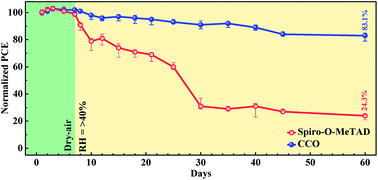Hydrothermally processed CuCrO2 nanoparticles as an inorganic hole transporting material for low-cost perovskite solar cells with superior stability†
Abstract
Despite the impressive photovoltaic performances of perovskite solar cells (PSCs) with a power conversion efficiency (PCE) beyond 22%, intensive studies are still required to overcome ongoing issues such as cost, stability, and hysteresis. Here, for the first time, we report a cesium-containing triple-cation mixed-halide perovskite solar cell (n–i–p structure) by using hydrothermally synthesized inorganic CuCrO2 (CCO) delafossite nanoparticles as a hole transporting material (HTM). After optimization of the concentration, a fully homogeneous and completely covered CCO layer that facilitates fast carrier extraction and collection was obtained on the surface of the perovskite. Our CCO-based cells achieved the best PCE of 16.7% (average 16.04 ± 0.40) with negligible hysteresis. More importantly, it was found that our cells showed a significant improvement in stability in ambient air compared with Spiro-OMeTAD HTM-based cells. After 60 days of storage in air without encapsulation, PCE remained at ∼83% of the initial value with the CCO-based cells, whereas it decreased to ∼24% of the initial value with devices based on the Spiro-OMeTAD HTM. Furthermore, cost estimation results indicated that the current prospect of CCO has an affordable cost/device ratio (∼180-fold cheaper than Spiro-OMeTAD). This work not only reveals the importance of air-stable inorganic HTMs, but also provides a low-cost HTM for highly efficient and stable PSCs.



 Please wait while we load your content...
Please wait while we load your content...